This post explains bicycle front derailleur compatibility of various makes and models. For a detailed explanation of front derailleur (FD in the rest of this post) mounting systems, cable routing and capacity, read this article: Front derailleur.
Before you start, to avoid any misunderstanding:
please take the 5 minutes needed to read the compatibility articles use instructions.
If you have any questions (or additions and corrections), please use the BikeGremlin forum’s compatibility section:
https://www.bikegremlin.net/forums/bike-compatibility/
FDs differ in several categories (they are all explained with pictures in the above linked Front derailleur article):
- Mounting: braze on, clamp mounted, or direct mounted
- Cable routing: top pull, bottom pull, or bidirectional pull (double pull)
- Big front chainring teeth number that FD is designed for and mounting angle
- Number of front chainrings: double vs triple
- FD cage rotation relative to the clamp position: high clamp, low clamp, or the new Shimano side-swing
- MTB vs Road FD
- Number of speeds (number of rear sprockets and chain width) FD is designed for
- Exceptions
TL/DR
Briefly put:
With front derailleurs, it is important to have their cage match the curve of your largest chainring, and to have their movement match the amount of cable your shifter pulls/releases.
Yes, it is always safe to buy a matching set of FD, cranks and shifters, but that’s not always practical (depending on what you already have or can source) or it may not always give you the gearing range that you need.
That’s why this article lists and explains the things that you should pay attention to when mix-matching.
1. Mounting
FDs are made for mounting on frame fixed braze on, or come with clamps for mounting on the seat tube. If FD comes with a clamp, seat tube diameter must match the clamp diameter. A newer standard, used on mountain bikes is the direct mount, it is explained at the end of this chapter.
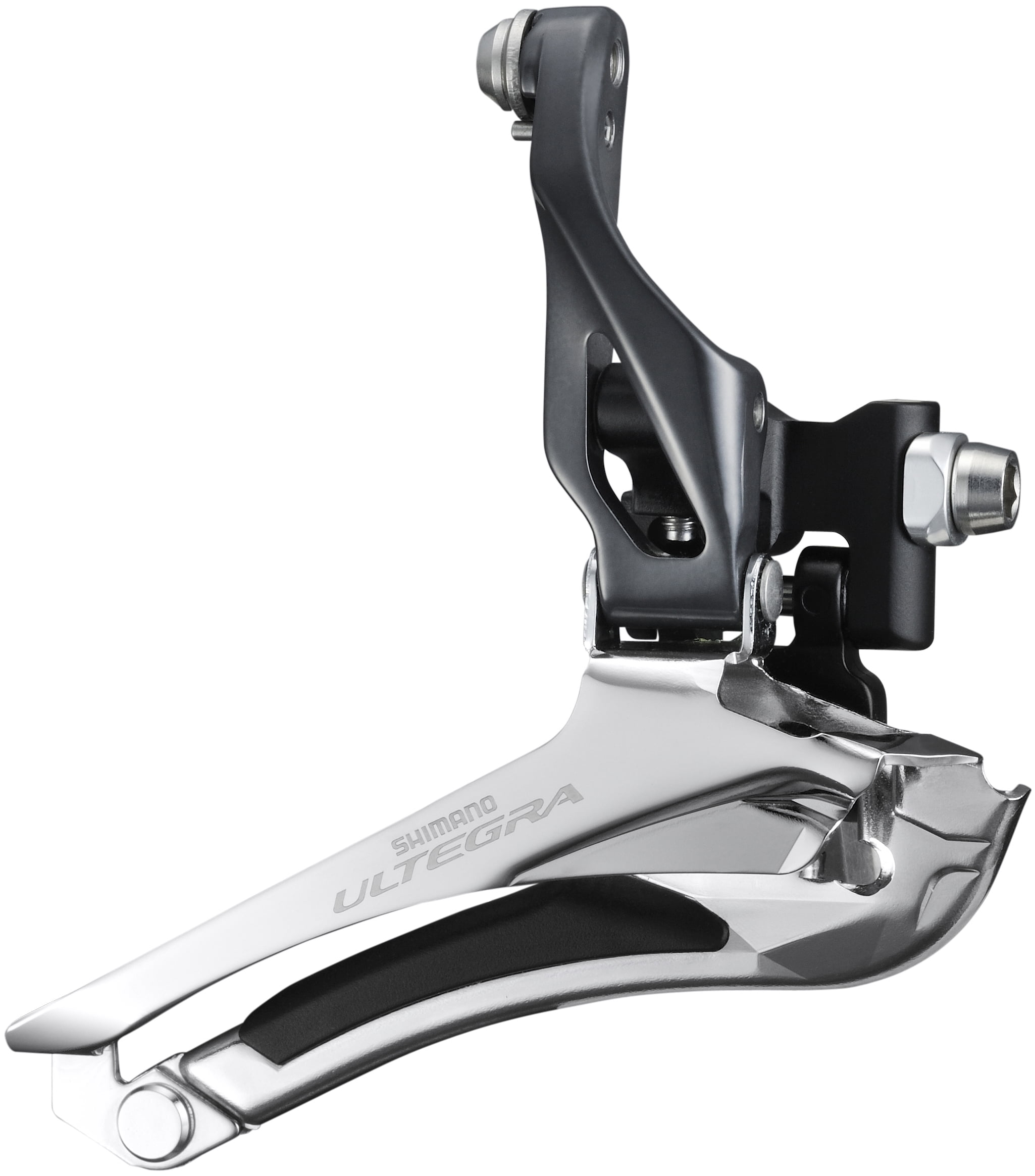
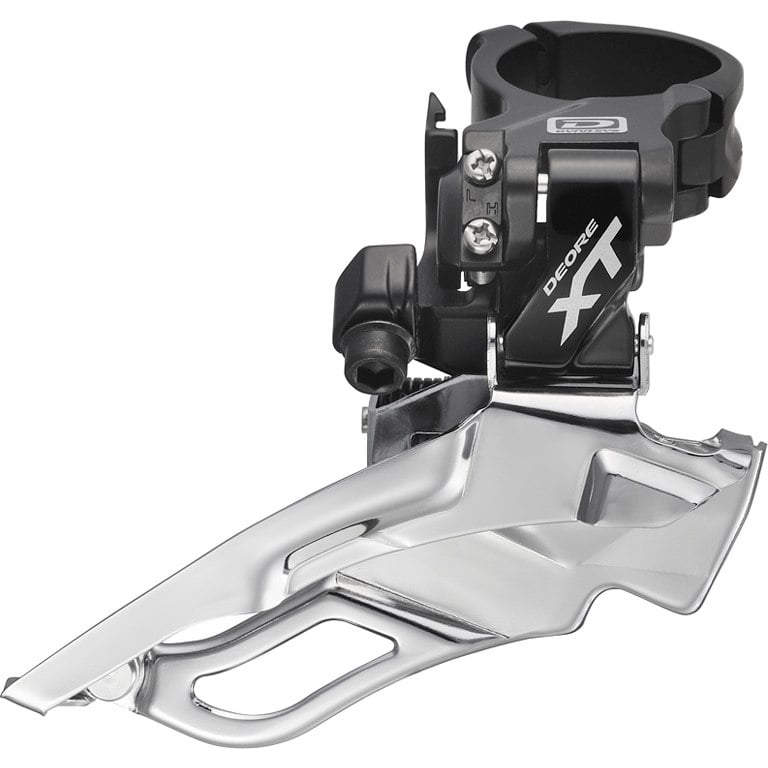
If a frame comes with a brazed on FD mount, in order to mount a clamp on FD, the frame mount must be removed (cut off). In some (rare) cases the clamp can be put above/below the frame mount, so it can stay, as long as it doesn’t interfere with FD movement and proper mounting relative to the front chainrings.

Standard clamp (and seat tube) sizes are:
1 1/8″ (28.6 mm)
1 1/4″ (31.8 mm) and
1 3/8″ (34.9 mm)
If a FD is a braze on type and the frame doesn’t have a FD hanger (or the frame hanger is too low/high for the size of front chainrings used), a separate clamp can be bought so that FD can be fixed to it. This is a much more universal type of FD.
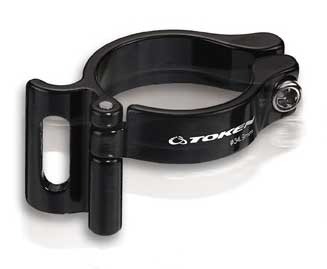
It is used when a braze on front derailleur needs to be mounted on a frame without derailleur holders.
Direct mount FDs can often be fitted to a frame without direct mount attachment holes using an adapter, enabling the FD to be secured by a (threaded) BB shell. There are also adapters for frames with a round seat tube cross section of a standard width, so that a direct mount FD can be attached to them.
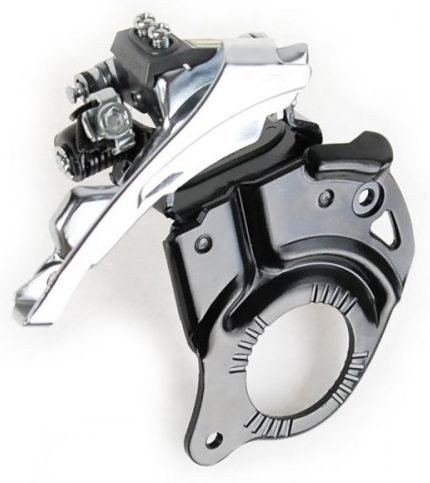
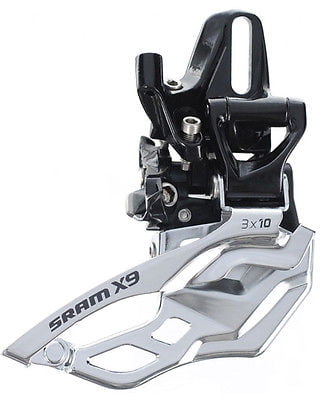
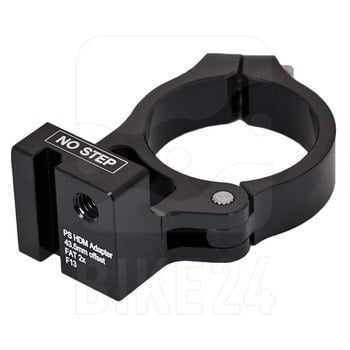
Frames with exotic seat tubes (either by cross section that isn’t round, or by diameter that varies from the three standar sizes), often have FD mounts made on the frame. If, for any reason, those mounts can’t be used (damaged, or not fitting the FD at hand), an adapter can be used – held in place by the BB shell – for frames with a threaded BB at least.
2. Cable routing
There are FDs that have a cable attached from below, from above, or from any of the two. Frames usually have only one type of cable routing.
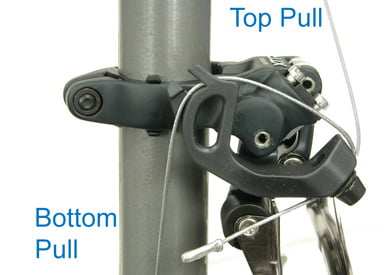
Enables routing from either side. Here, two cables are routed, from the top and from the bottom. Of course, only one cable is mounted in real life – either from the top, or from the bottom. Never two! 🙂
With double routed FDs this isn’t important, but for the other models, if the FD’s cable routing doesn’t match the frame design, there is a special adapter that can reverse the cable direction.
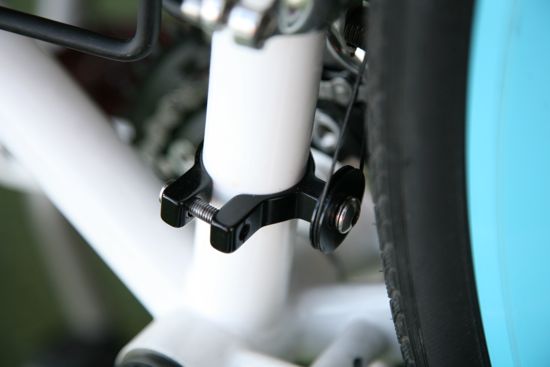
Enables reversal of cable routing to the front derailleur.
In the picture above, the frame has cable routing so that FD cable comes from above. FD is designed for bottom cable routing. The adapter with a wheel onto which the cable is placed is mounted on the seat tube below the FD, so that the cable can go over it and up to the FD. Everyone is happy. 🙂
Almost all the road FDs have bottom pull cable routing, while most MTB FDs have either top, or dual cable pull.
3. Teeth number (the size) of the largest front chainring a)
and mounting angle b)
a) teeth number
FD is curved in order to align with the curve of the largest front chainring. A typical MTB chainring has 42 teeth, while road bike chainrings often come with 53 teeth. A smaller chainring requires the FD to have a much more curve in order to align (and vice versa).
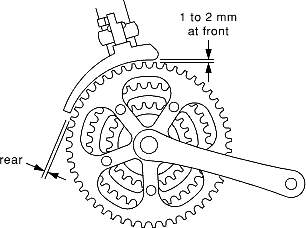
Imagine in the picture above that the FD cage is shaped to match the middle chainring. It would have to be mounted either too high, or it’s rear part would bump into the big chainring, since it has too sharp a curve.
FDs are usually made to match chainrings with 42, 48, 50, or 53 teeth. If FD and large chainring are mismatched for a couple of teeth, there’s no problems, it’s close enough. If, however, a difference is large, the following problems occur:
- Chainring has a lot more teeth than the FD is designed for: like explained above. FD will have to be mounted too high, which will make shifting slow, poor and might cause chain rub on the rear lowest part of the FD after shifting onto the smallest chainring.
- Chainring has a lot less teeth than the FD is designed for: front part of FD will be correctly positioned, while the rear part of the cage will remain high up, and the chainring curves sharply down. It will not align. This will not hurt shifting, but will cause a lot of chain rub on the FD cage – as soon as some shifting gears in the rear sprockets causes minimal amount of cross chaining.
b) mounting angle
Seat tube angle (onto which FD is mounted) is usually about 70 to 73 degrees for road bikes, while MTBs usually have a bit steeper seat tubes (closer to vertical vertical compared to road bike ones), of around 75 or more degrees. If a FD designed for a more vertical tube is mounted on a tube that has a less vertical angle, the effect will be similar to that of combining a FD designed for a lot smaller chainring, with a chainring that is bigger. And vice versa.
Though this is a bit misleading. For a full disclosure: modern road and MTB frames don’t really differ all that much by seat tube angles. What differs is the angle between the chainstay and the seat tube. MTB bikes have that angle a lot smaller, compared to road bikes (by roughly 5, or more degrees), and that is the angle that matters as far as front derailleurs are concerned (see the next paragraph, below the picture).

The rear part of the cage is too high, even though FD is mounted at the correct height.
It is worth noting (thanks to Drew for pointing it out) that frame manufacturers provide seat tube angle as measured from horizontal (which matters for riding position fitting), while Shimano (for one) notes their front derailleur angle as the one between the seat tube and the chainstay (which actually is what matters for the front derailleurs). So those (“Shimano”) angles are often 61 to 66° degrees for road FDs, and 66 to 69° for MTB front derailleurs.
Similar problems can occur if the mounting position isn’t correct – happens on some special, or custom built frames.
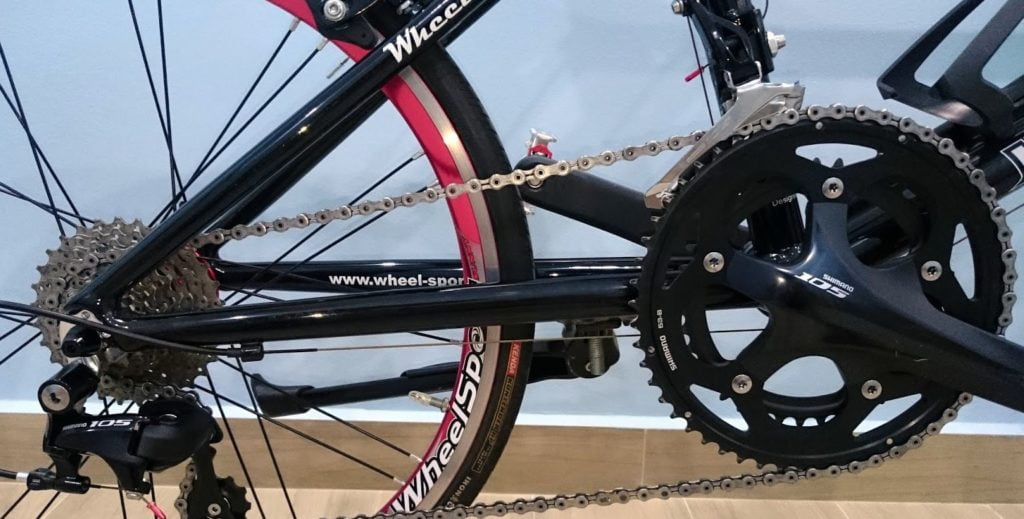
A specific case.
If a FD is a braze on mounted type, this can be corrected with made adapters:

4. Double vs triple
FDs are made in two variants: for double and for triple front chainrings.
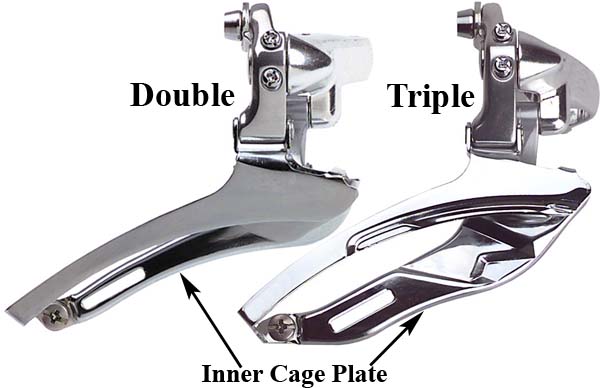
Double FD will work with a triple chainring if the difference in teeth number between the smallest and the largest chainring is rather small (which defeats the purpose of a triple chainring though). For example a 34-42-48 chainring. Also, if the operation (movement) of the FD is limited to the two largest chainrings, it can work OK.
Triple FD will work on a double chainring if the difference in teeth number between the chainrings isn’t bigger than 12. One can “get away” with 14 as well, but the lower difference, the better.
Compact cranksets, with two chainrings that vastly differ in size (usually 34-50 combination) will work well only with double FDs with the curve appropriate for the big ring size (50 to 52). Even when using a double FD, it is best to keep the tooth cound difference up to 16 (like with 34-50, or 36-52 chainring combinations).
5. High clamp, low clamp, or side-swing
With older standard for FDs, the cage is below the mount, so that FD cage swings below the FD body. These are the high clamp FDs. Low clamp is a newer Shimano system meant for MTBs with rear suspension. FD cage is practically in line with the mount. This leaves more room for mounting the rear suspension to the seat tube. Previously used terms for this were bottom swing (for high clamp) and top swing (for low clamp), but with the introduction of Shimano side-swing system (explained at the end of this chapter), these terms are no longer precise enough.
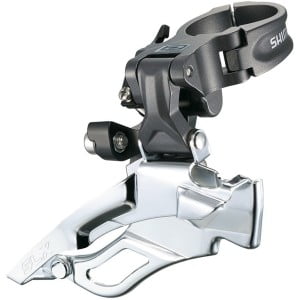

If the bike has no rear suspension, or there is enough room for a standard FD below the suspension, it is irrelevant which type of FD is mounted (as long as it’s suitable in terms of other explained criteria – angle, size etc.).
The newest Shimano system is the side-swing, where the cage rotates sideways. These FDs can be clamped with a high clamp, low clamp, or using a direct mount system.
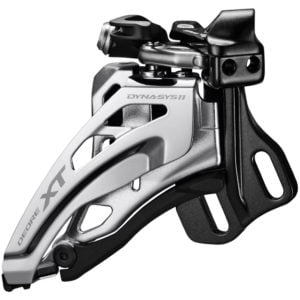
6. MTB vs road FD
Shimano road and MTB FDs have different cable pull ratios – that is the amount of FD movement for each mm of cable movement. This means that MTB FDs might not work well with indexed road shifters and vice versa.
With double chainrings, this issue can be fixed by adjusting limit screws and it could be made to work (if not perfectly). With triple chainrings, it is harder to get it to work properly. However, the FD cage is a lot wider than the chain and triple FDs have just 3 positions you need to “match” (unlike reaer derailleurs with 6 to 13 different positions), so depending on the particular shifter – FD combination, even that can sometimes be made to work OK.
Note that MTB shifters usually have 2 clicks (for a total of 3 FD positions), while road bike STI shifters have 2 “full clicks” and 3 “trim” clicks (for minor FD position adjustments), so a total of 5 clicks/positions. Friction shifters, of course, give you an unlimited freedom in terms of fine-tuning the FD’s position. 🙂
Having said all this and in spite of officially different cable pull, some FDs work OK with all the shifters, regardless of whether it is road, or MTB. Exception are the Shimano 11 speed road FDs and Shimano Tiagra 4700 10 speed FDs – they have a (vastly) different cable pull (and cable anchor arm), so they are not compatible. So, while this will not shift perfectly, especially with triples, it is worth giving a try and seeing if it’s good enough for one’s criteria – if what one has on hand are mismatched road and mtb shifters and FDs. If it doesn’t work satisfactory, the cheaper option is to find a FD that matches the shifter.
7. Number of speeds
The last AND the least important. 🙂
FDs are made for a certain number of speeds, i.e. number of rear sprockets. The more speeds, the narrower the chain. There are FDs for 6 to 8 speeds, then for 9, 10 and 11 speeds. Cage width is made to match the planned chain width.

and 10 speeds (right)
However, since the chain moves left-right on the rear sprockets, FD cage is a lot wider than the chain. That is why it is possible to mount a 10 speed FD and use it with a 6 to 8 speed chain.
FDs are very forgiving in terms of speed number (even in terms of manufacturers), so they can be mixed and matched. One of the few pieces of equipment where it is possible to change a Campagnolo 10 speed with a Shimano 8 speed and it all works.
When a FD for more speeds is put on a chain for fewer speeds, the only bad effect is more chain rub. Since the FD cage is narrower, smaller angling of the chain (when changing gears at the back) will cause it to rub the FD cage. With indexed shifters, a trimming option can help, while with friction shifters this is not an issue.
8. Exceptions
Exception to this rule are Shimano 11 speed road FDs. They will not work very well with anything but Shimano 11 speed road shifters and Shimano Tiagra 4700 10 speed road shifters. Same goes for Tiagra 4700 FDs. Newest Campagnolo 11 speed system: Revolution 11+ (older one is Revolution 11) also requires matching (Revolution 11+) shifters and derailleurs. The reason for incompatibility lies in different cable attachment and amount of needed cable pull per gear change. Why was something that had already worked “fixed” has probably more to do with the marketing, than with the engineering department of the company.
Another exception is the new “gravel” group (with hydraulic brakes): Shimano GRX. Caple pull wise it’s the same as Tiagra 4700.
Help BikeGremlin
stay online & independent
This website is educational, free, objective, and not commercial
(sponsors don’t enjoy paying if you mention all the product downsides that you notice 🙂 ).
How much does a WordPress website cost?
If you find this site to be good and helpful,
and if $5 per month is what you can afford to set aside,
please consider supporting my work with a Patreon donation:
Related post – Front derailleur:

Compatibility posts are also available in eBook (printable and Kindle) and paperback editions on Amazon:

If you have any questions (or additions and corrections), please use the BikeGremlin forum’s compatibility section:
https://www.bikegremlin.net/forums/bike-compatibility/
The existing comments (questions and answers) posted under this article were moved to this BikeGremlin forum thread:
https://www.bikegremlin.net/threads/compatibility-05-front-derailleurs-article-comments.101/

Hi Bikegremlin,
Can you solve a problem for me please?
I have fitted Sora 8 spd triple sti shifters and I can’t get them to work with the XT FD.
The chainrings are 44/34/26. (Are these sizes the real problem)?
I have been offered an old Dura Ace FD-7400 which I am told may work. (Although it’s a double).
Otherwise I have a Sora 9 speed Triple FD?
Or should I just go with a Sora 8 spd triple one?
If none of these, then what?!
The bike is a lovely old Basso lugged bike and I am trying to keep it ‘in the era’!
Thank you for any help.
There are several things to consider here. First thing that pops to mind: does FD cage curve fit (follow) the curve of the largest chainring? That’s as far as the sizes go.
Now, generally speaking: triple FD is more likely to work properly on a triple chainring, than a double FD.
Also – both 8, an 9 speed road FDs are more likely to work properly with road shifters, than an MTB FD. 9 speed one might have a bit narrower cage, so the 8 speed chain may be more likely to rub when riding cross chained, but that is not advisory anyway, so one could consider that as a “fair warning” to change the gearing combo, more than a problem/malfunction.
Having said that, Sora FDs are more likely to have their cage shaped to fit a 50 tooth largest chainring, not a 44 tooth one. So in those terms, a matching MTB FD might have an advantage. The problem with those is their cable pull differs a bit compared to the road ones. However, I have used MTB FDs with Sora STI’s with no problems. It isn’t perfect, but it shifts and works. A friend, who is also a mechanic, is having problem with such setup though. Trying to talk him into hopping to my garage, before buying a new FD. If he does, I’ll take a look at it and, if he isn’t in a rush, try to record a video of the (hopefully successful) procedure.
The section on derailleur mounting angle is confusing, as written. In English, (American English, at least) steeper implies more vertical and perpendicular. I would write “Seat tube angle (onto which FD is mounted) is usually about 70 degrees for road bikes, while MTBs usually have a more relaxed seat tube angle, around 65 degrees. If a FD designed for more vertical tube is mounted on a tube that has a more relaxed angle, the effect will be similar to that of placing a smaller chainring designed FD on a much bigger chainring. And vice versa.”
It might also be useful to make a note that Shimano trekking and MTB derailleurs often come in two orientations, 63-66° chainstay angle (not to be confused with seat tube angle) which is common on road bikes and 29ers… and a 66-69° chainstay angle which is common on older mountain bikes with a 26″ wheel.
Thank you, Relja, for all the hard work you put into this helpful website!
Thank you for the feedback – it’s very good.
I have edited (in fact corrected) the article. I think, thanks to your feedback, it is more clearly explained now (if even a bit more long 🙂 ).
For laughs: analyzing the mistake – in my native, we use words translated as “sharp” for below 90°, and “blunt” for over 90° angles. Seems I have “switched” the words “steep” and “sharp”, using them as if they’re synonyms in this context, while they have opposite meanings.
While the angle originally noted for MTB seat tubes was in fact average seat tube to chainstay angle. While trying to make the article less outrageously long, I wasn’t sure whether to use that, or the frame angle. Ended up mixing them – without ever noticing it. Still, with your feedback, I suppose an extra two paragraphs explaining that do a lot more good than harm – for anyone interested in this topic.
P.S. The amount of high quality feedback (both on the websites and YouTube channel) never ceases to amaze me. Over the years, it has helped make them a lot better, a lot more useful – both to myself (I usually use my websites as a reference/reminder, especially the compatibility and standards articles – can’t keep it all, always, in memory 🙂 ), and, hopefully, the other cyclists/mechanics. Cycling community seems surprisingly supportive, at least in my experience over the past decades.
Hi Relja,
First, let me thank you for all the helpful info !
I am doing my first build: converting my 2001 Klein Attitude into a 27,5 Gravelbike. I’m almost there but (of course) it’s the shifting I’m struggling with. I have 3×9 Sora Sti shifters I’d like to use with the existing 3×9 drivetrain (which is still in very good shape). Now the 9 speed front derailleur needs more cable pull than the Sora STi’s offer so it will either not work with or will work poorly I’ve read. I also read I can fix this by
1. get a 9 speed mtb derailleur and replace the Sora’s with Campa Ergo and go ‘Shimergo’
2. stick with the Sora’s and 9 speed mtb derailleur and buy a Shiftmate7 from Jtek
Frankly, I’m not thrilled about option 1 [hassle] nor option 2 [yet another adapter..]
So I thought about option3 and I’m curious if you think it can work (or better, if you’ve tried it):
3. get a 3×8 FD like the Shimano FDM310X6. My theory is: because of the slightly larger cage, the lack of cable pull from the Sora Sti shifters will be compensated. You’d start off on the BB side with the left side of the cage at a normal position which would give some extra room on the right side which you need when you shift to a larger chainring.
Very curious what you think !
Thanks in advance for your response.
kind regards
Wilfred
PS Looking at the specs the FDM310X6 ticks a lot of the other boxes [chain line, angle, teeth].
Hello Wilfred,
If I understand correctly, front shifting is a concern.
Sora front shifters (all the models up to date) are compatible with any Shimano road FD except the new 11 speed (and the new Tiagra 4700 10 speed ones… and Shimano GRX… see where both me and Shimano are going with this? 🙂 ).
So any road FD for 3 speeds (different cage shape compared to 2 speed FDs) should work fine.
Before buying, I would check if it can be configured to work OK with the existing (MTB I assume) FD.
In case shifter pulls less cable than is optimal, a “hack” I use is to start with the cable just slightly tighter (up to the point when downshifting to the smallest chainring is a bit “lazy/slow”, but still works properly).
That often gets it just right for the middle chainring, and still fine on the largest chainring, if with some slight chain rub when using the smallest rear sprocket.
Potential problems with using a road triple FD depend on the cranks. MTB cranks with 28-38-48 tooth count are more likely to work fine with road triple FD-s, generally designed for 30-39-50 cranks.
On the other hand, smaller MTB cranks, like 24-32-42, are going to see FD cage being too straight for the largest chainring curve. Which can affect shifting, and cause chain rub even when the chain is not severely crossed.
Bottom line:
The only really “safe bet” is to buy everything new, matching all the components (which can be both wasteful, and needlessly expensive in my opinion).
Everything else is a bit of “hacking” – and quality results require a bit more tuning, and also depend on how strict one’s criteria for “OK” are.
Long ago have I completely switched to friction shifters, never to look back.
I tune other people’s bikes, especially when they mix-match, but for my own – I prefer something that just works, reliably, always, even if (when) something gets whacked against a tree, or a rock on a ride (I fall down – a lot 🙂 – always keeping it on the edge 🙂 ).
Regards,
Relja
Hi Relja.
Great article, I found it to be very helpful.
Recently I broke the left shifter of my claris r2000. Im planning to change it to a tiagra 4700 shifter (left only) along with the 4700 fd.
Would this cause any compatibility problem as I plan to keep the rest of the parts still with my claris.
Regards
Nabiel
Hi Nabiel,
I’m afraid Tiagra shifters won’t work with the Claris compatible derailleurs (and vice-versa).
Regards,
Relja
Thanks for the fast reply Relja
Would the Tiagra 4600 shifter work with the claris r2000 fd?
Thanks
Regards
Nabiel
Tiagra 4600 shifters will work with Claris derailleurs. Both the front, and rear (provided a cassette is chosen to match the shifter’s number of speeds). 4700 won’t, but 4600 will.
Hi Relja, I am running a 10 speed setup with hydraulic disc brakes. I have been using RS405 shifters with a 105 5700 rear derailleur and, because the frame is top pull for the front derailleur, I have a CX70 front derailleur. Since my right hand shifter failed recently I decided to go for a set of GRX RX400 shifters, so keeping with 10 speed. I now discover that shimano have changed the cable pull on these shifters to be the same as 11 speed systems. I have purchased a 4700 rear derailleur to be compatible. Can you suggest a top pull front derailleur that would be compatible, or should my CX70 work with the RX400 shifters?
Just as is the case with the rear, the front shifter will require a “Shimano road 11 speed” compatible FD (not sure how else to name it, since that cable pull is now introduced in 10 speed road, and 10 & 11 speed “gravel”).
The road FDs work only with bottom cable routing.
I’m not sure if FD-RX400 is designed for bottom (or dual-side) cable routing. If the frame allows it, a work-around can be done using a cable routing adapter (as shown in the 2nd picture of the 2nd, Cable Routing chapter of this article).